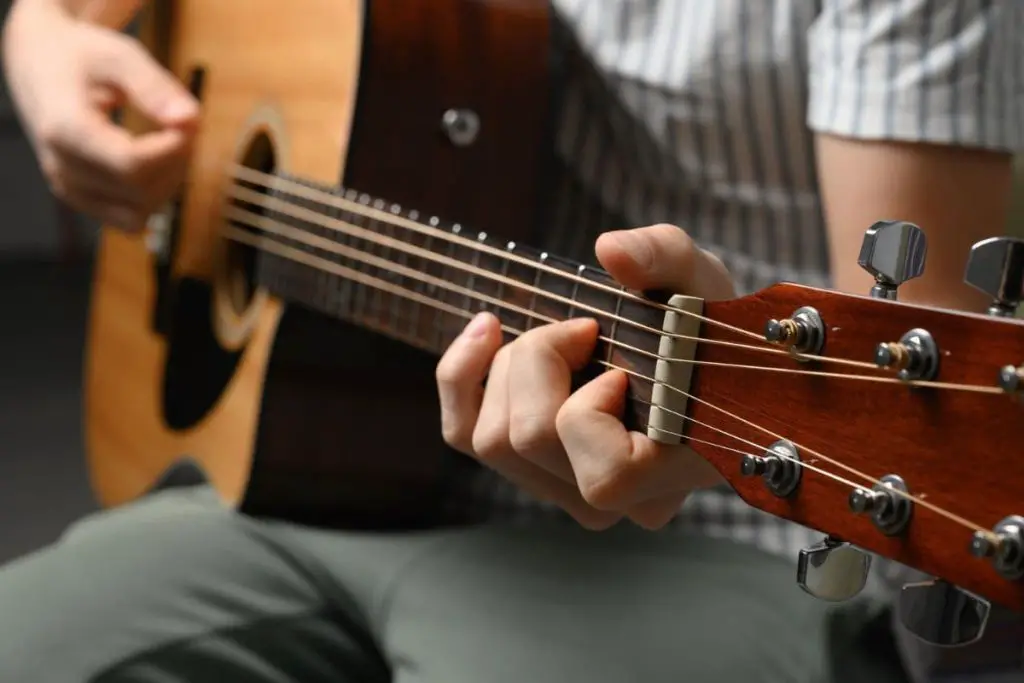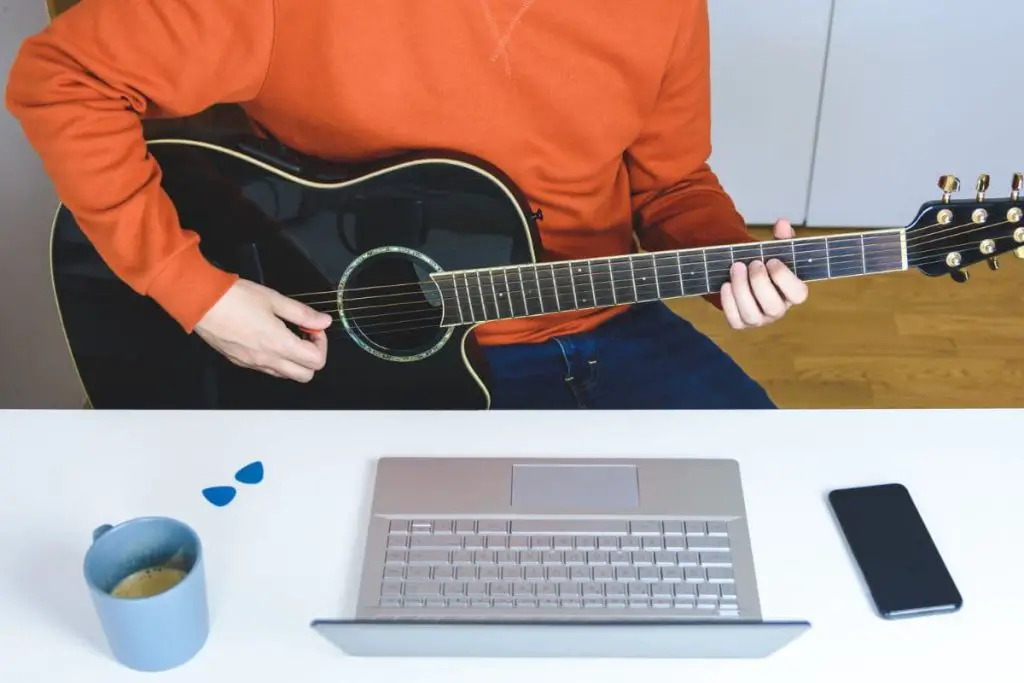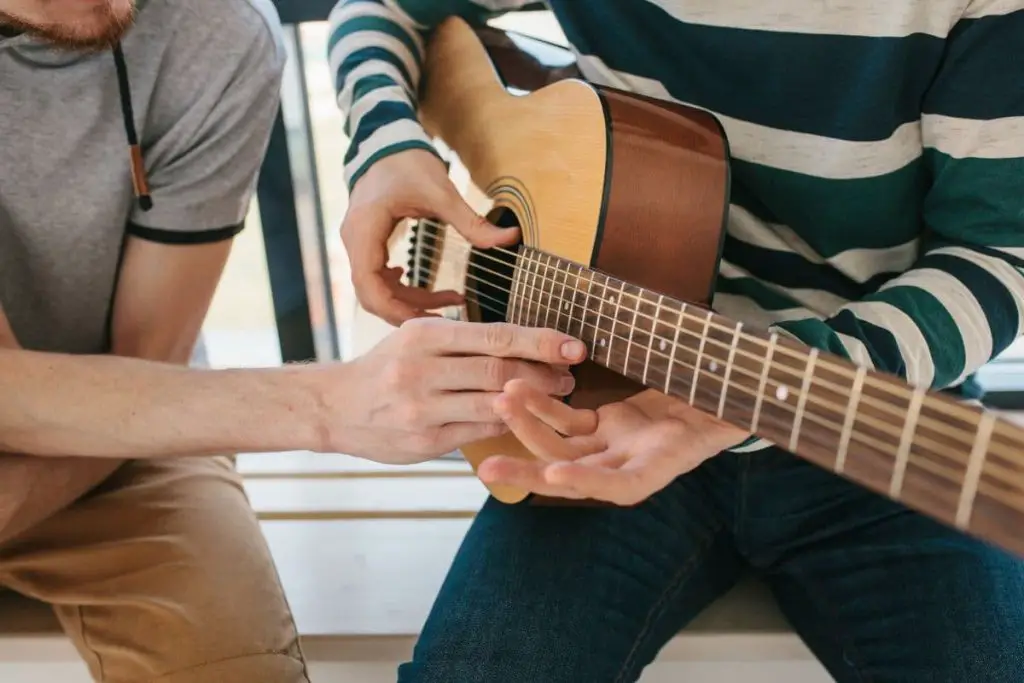Chord charts are generally a great tool for learning how to play songs. They tell you which chords to play and give you a rough idea of how long you have to play them and when to switch. However, sometimes this might not be clear enough, especially in a more complex song, and many guitarists get stuck, unsure when to change chords.
If you want to learn when to change chords, listening carefully and experimenting are the two most important skills. You have to familiarize yourself with the key of the song and the common moments when you can change chords. It’s also important to jam with other people.
If you struggle with figuring out when to switch chords in a song, don’t worry. This article will explain everything you need to know on this topic, so you’ll be ready to easily conquer your guitar goals.
If you want to find out what my recommended guitar gear is, then here is what I recommend on Amazon:
- Fender Cutaway Acoustic-Electric Guitar Bundle (MY FAVORITE GUITAR)
- Snark SN-8 Super Tight All Instrument Tuner (Easiest Tuner I’ve Used)
- 6 String Acoustic Guitar Capo (Best CAPO for quick changes)
- Dunlop Max Grip 1.0mm Nylon Picks (Thick Guitar Pick So You Don’t Lose Grip!)
- Universal Guitar Stand (Cheap & Minimalist Guitar Stand I Recommend)
- Levy’s 2″ Wide Quick Adjust Guitar Strap (Best Guitar Strap For Any Level)

How To Know When To Change Guitar Chords in a Song: When Do Chord Changes Happen in a Song?
Before jumping deeper into this topic, it’s important to first familiarize yourself with how chord changes usually happen in a song. It goes without saying that they aren’t random, so understanding when they happen will help you predict when you’re supposed to change the chord in the song you’re playing.
Of course, there are many variations, but most songs in popular music roughly follow the same rules. The beat is usually 4/4, which makes things pretty easy for a prospective guitarist, and the chords usually change in these three situations:
- Once every measure
- Once every two measures
- In the middle of the measure
We’ll explain these chord changes in a minute, but before that, let’s go back to the basics and see what a measure is in music.
What Is a Measure?
A measure (also known as a bar) in music is a group of beats you play at a certain tempo. Music sheets are usually divided into measures to create bite-sized pieces that are easy to read and understand.
For example, if you have a 4/4 time signature, there are four beats in the measure, and each one lasts a quarter of the measure. 3/4 means there are three such beats in the measure. Many other variations exist, but these two are the most common in Western music.
Most of the time, you’ll play in these time signatures unless you play progressive rock or something like that. In that case, you’re probably skilled enough not to need this article, so we’ll stick to the easiest time signatures for simplicity.
Now that we know what a measure is, let’s take at the most common chord change options.
Chord Changes Every Measure
Chords often change after each measure, especially if it’s a simple song. This is the easiest option, and it’s not difficult to pick up these changes. As a rule of thumb, the chord changes at the beginning of the measure, meaning it’ll change on the first beat.

If you’re playing a song with this structure, tap your foot to the beat and change the chord every four beats. It’s a piece of cake; you’ll be able to nail this in no time. Start slowly and increase the tempo as you get a better feeling for the rhythm. Focus only on the beat at this stage.
Chord Changes Every Two Measures
Another common option is changing the chord every two measures. This functions in pretty much the same way as the previous option; you just strum each chord twice as long. This case might even be easier as you have to move your fretting hand less often and have more time to get into the rhythm,
This pattern might be extended almost indefinitely. Sometimes you’ll find songs in which you have to stay on the same chord for up to four measures. This is so easy that you might forget you even have to change the chord.
Remember to count the beats, not the times you strum the chord. While the latter might help you get it right, it doesn’t let you develop a good sense of rhythm. You might learn one song more easily, but it’ll hinder your long-term progress, and you won’t develop your full potential.
Chord Changes in the Middle of the Measure
Sometimes, things might get a bit complicated, so you’ll have to change chords in the middle of the measure. This is usually done on the third beat, which might catch you by surprise if you are not fully concentrated.
Sometimes, you’ll even have a mix of these situations. While this might be harder to learn, it’s a great way to liven up your songs if you’re a songwriter. Chord changes that are too regular will make your music sound robotic, and it won’t be as catchy and exciting as unpredictable music.
Of course, you should not overdo it. You should entertain your audience and make them dance. Nobody wants to hear a chord salad in a weird time signature they can’t vibe to. Don’t show off when writing your chord progressions.
Familiarize Yourself With the Scale
We get it—scales are boring and you’d most likely rather watch paint dry than practice them. However, learning the basic scales will make it much easier for you not just to learn how to play songs, but also how to write them.

Before learning a new song, see which key it is in. This will tell you which chords to expect in the song. While this technique won’t necessarily tell you when to change chords, knowing what to expect will allow you to change chords much faster.
This is particularly true when you can’t see your chord sheet or are not exactly certain which chord goes next. Having a good grasp of scales will let you make educated guesses on which chord to play next, which, in turn, will make your playing smoother.
Listen Very Carefully
Listening carefully is the most important thing when it comes to figuring out the chord changes in a song. When learning a song, make sure you listen to it very often, but not passively. Don’t just blast it in the background.
Play it, separate yourself from distractions, and listen for changes in the music. Tap your foot to the beat to help you figure out on which beat the chords change. Try to pay attention to the rhythm and music rather than singing.
Chord charts always place chords above certain words in the lyrics. There’s simply no other way to indicate when the chord changes in that type of situation. But it’s not the best way to do so. Chord changes don’t always align neatly with the singing, so it’s not the most reliable way of learning the chord changes.
Not to mention that it’s sometimes hard to place the chord in the right spot in a word processor, and sometimes people simply make mistakes.
Therefore, rely on the instruments in the song to figure out when you’re supposed to change the chord. Listen to the song very carefully a couple of times before you start practicing. Make mental notes of when the chords change.
For example, chord changes often align with strikes on the crash cymbal and they’re sometimes preceded by a drum fill. The latter is often the case when a song moves from one section to the other. In other cases, a chord change is preceded by a bass fill which tells you that the measure is almost over.
After that, take your guitar and start strumming lightly. Don’t play with full volume until your strumming aligns well with what you hear in the song. You can even unplug your guitar (if you’re playing an electric) and strum silently.
While this method is not particularly fast, it’s the best one in the long run. It allows you to develop a good sense of rhythm, making it increasingly easier to learn new songs as you get more experienced.
What’s even more important, it will make it easier to pick up new songs and stay in the rhythm if you start playing in a band. You’ll lock in with the rhythm section much more easily than someone who rushed their practicing.
As a beginner, you might find this excruciatingly difficult. But if you stay consistent, it’ll become second nature to you. The more you practice, the less time you’ll have to listen and prepare, and you’ll eventually nail the rhythm after one or two attempts.

Use Down Strums at First
While you’re not supposed to go full Johnny Ramone and only ever use down strums, doing so when you’re first starting to learn a song will make it a bit easier, especially if you’re a beginner. If your goal is to nail the chord changes, it might be easier to pull that off if you focus only on that and keep strumming in the simplest possible way.
Once you nail the chord changes, you can slowly work the proper strumming pattern into your playing. You don’t have to do everything at once. You’ll easily pick up the strumming pattern once you memorize the chord progression.
As you gain experience, you’ll probably get the strumming pattern right away. It will take some time to get to that point, so trust the process and have patience. No one becomes a pro overnight.
Don’t Include Singing Right Away
If your goal is to sing while playing, it’s best to include singing later. First focus on the playing, make sure you can nail the guitar part without even thinking about it. Then include the singing.
Singing too early can throw you off quite easily if you’re not well-versed. Of course, it’s not impossible to play and sing at the same time, but it requires experience and strong guitar skills.
As a beginner, you probably won’t be able to do this immediately unless you’re a really talented musician. Take things step by step, and don’t rush anything. As you get confident in your playing, start humming the vocal line.
As this becomes easier, try singing, improving the enunciation and increasing the volume. It will probably take a few attempts, but you’ll nail it eventually.
As always, take things slowly, and don’t rush. There’s plenty of time to learn everything you want to learn, and even if you’re facing difficulties initially, it doesn’t mean that you’ll be unable to overcome them.
Jam With Other People
Sitting in your bedroom and strumming away isn’t enough to truly feel the music you play. While this might get you far, and will allow you to learn a lot, nothing beats getting together with a couple of friends and playing.

Let’s examine how this can help you figure out chord changes.
It’s More Dynamic
Playing with a group of people feels completely different from jamming to a song or a backing track. While in the latter case, you might feel like an addition to the music, in the first case, you’re an integral part of the sound you hear.
Learning how to lock in with the drums, bass, and other guitars (if there are any) will enhance your sense of rhythm and feeling for the music you’re playing. Playing with people is also an additional challenge because you constantly have to be aware of what everyone else is doing, and things are much more dynamic.
Every time you play a song, it’ll be slightly different. The drummer might be a bit faster or slower, or they might throw in a cool fill. The bassist might play a groove differently than usual or add something new to their line. These are things you have to adapt to, and the more you learn to adapt to new situations, the easier it’ll be to learn new music and advance your guitar skills.
Additionally, jamming with others will give you additional visual clues that tell you when to change chords. If there is another guitarist in the band, you can watch them play and see when they change chords, which you can copy. You can also watch the bassist and see when they move from one chord to another.
Of course, you shouldn’t overuse this, as it might hinder your progress. It might give you a great hint, but memorize when the chord changes and play from your memory. Constantly copying the other guitarist won’t let you develop an innate sense of the changes.
You Can Get Help
What’s better, the other musicians can help you if you’re stuck with the chord progression. Having someone to play the song slowly for you while explaining the details behind it will speed up the process. You may also learn something new about music theory.
On the other hand, if you’re alone, you have to rely on googling and watching tutorials. While this is not a bad way to learn, you still might find it hard to find the answers to some specific questions you might have, which will hinder your progress.
It’s also much easier to follow someone’s advice if they’re sitting next to you and taking you through the steps. Instructional videos can be helpful, but they’re almost always made for a general audience, and you might find it hard to follow their pace. Therefore, they can never beat help from a friend.
Don’t Overthink It
While you have to stay focused while playing music, especially in the beginning, music should not be exclusively a mind exercise. You shouldn’t overthink your guitar playing. Instead, focus on feeling the music.
Overthinking can bog you down, and diminish your pleasure when playing. This is not to say that you should not spend time thinking about the songs you want to play. Using the power of your mind to figure out how to play a song will give you a good start, but it’s much more important to listen and get the groove than to think and only understand music on an intellectual level.
Familiarize yourself with the basics of music theory, as we’ve discussed. But more importantly, practice and listen. Music isn’t always perfect, and it shouldn’t be. Quite often, something can be slightly off-beat, which may make it wrong in the strict sense, but it makes music come alive and feel special.
In such cases, thinking too much and trying to squeeze everything into mathematically perfect measures won’t help you. Hone your ears and practice until you get everything right.
Remember, music should be fun. It should be entertainment for both you and your potential audience, and you should treat it that way. A passionate performance will always be much better than a technically proficient performance with no soul in it. Play from your heart more than from your brain.
How To Know When To Change Guitar Chords in a Song: Conclusion
As a beginner, listen carefully to figure out when the cord changes happen and develop a sense of the song’s rhythm. You should also learn some basics of music theory to help you predict when changes happen and which chord goes next.
It’s also important to jam with other people to improve your sense of rhythm and learn how to function in a band. Getting help from your bandmates will help you immensely on your journey. Finally, don’t overthink the situation and stress too much about chord changes.
If you want to find out what my recommended guitar gear is, then here is what I recommend on Amazon:
- Fender Cutaway Acoustic-Electric Guitar Bundle (MY FAVORITE GUITAR)
- Snark SN-8 Super Tight All Instrument Tuner (Easiest Tuner I’ve Used)
- 6 String Acoustic Guitar Capo (Best CAPO for quick changes)
- Dunlop Max Grip 1.0mm Nylon Picks (Thick Guitar Pick So You Don’t Lose Grip!)
- Universal Guitar Stand (Cheap & Minimalist Guitar Stand I Recommend)
- Levy’s 2″ Wide Quick Adjust Guitar Strap (Best Guitar Strap For Any Level)
Related Posts:
- How To Play Bar Chords On Acoustic Guitar (Easy Beginner Tutorial)
- Happy Birthday Guitar Chords and Melody (Learn How To Play Easy)
- Cowboy Chords On Guitar: What are they? (Chart, Songs, Tabs)
- How To Learn Guitar by Yourself (Self-Taught with Resources)
- Examples Of Popular Song Structures
- Cowboy Chords On Guitar: What are they? (Chart, Songs, Tabs)
- Learn Guitar Notes: What Are The Notes On A Guitar?

